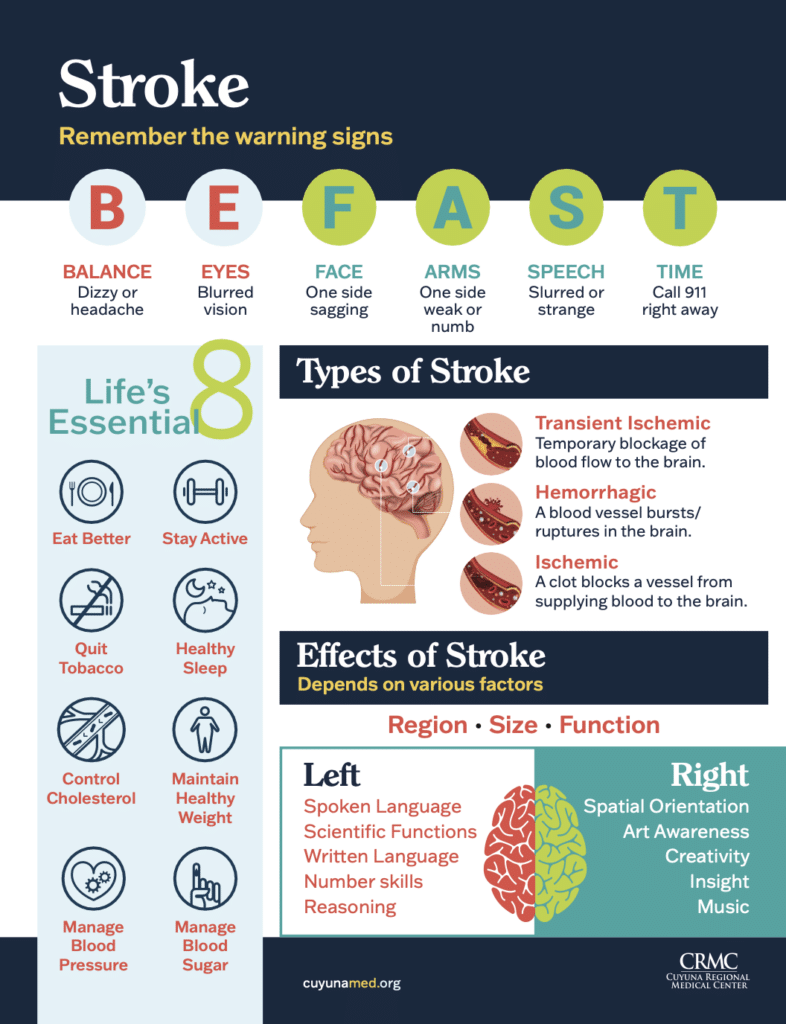Understanding Stroke Prevention: Recognizing Signs and Symptoms
A stroke can be a devastating event that can adversely change a person’s life indefinitely. It is the second leading cause of death worldwide, and up to 50% of survivors become chronically disabled. Unfortunately, it is a common cardiovascular event, with one stroke occurring every 40 seconds in the United States. Stroke prevention is crucial in reducing the incidence and impact of this life-altering condition.
Cuyuna Regional Medical Center’s Board-Certified Internist Mark Bostrom, DO, stresses that although not entirely preventable, there are ways to help reduce the risk of experiencing this potentially devastating event. “The most important way to reduce the risk is to have hypertension diagnosed and treated effectively. People over 50 need regular doctor visits to monitor their blood pressure and be evaluated for other risk factors, such as high cholesterol. Regular doctor visits will also help monitor for the occurrence of an irregular heart rhythm called atrial fibrillation, which is another leading risk factor for developing a stroke.” Dr. Bostrom went on to add that healthy eating habits and regular exercise are very important to help lower cholesterol and blood pressure as well as prevent, or limit, obesity, which is another significant risk factor for developing a stroke. “Another significant risk factor is smoking tobacco, so stopping smoking dramatically reduces the risk of a stroke. In patients with diabetes, it is important to control blood sugar optimally as this also reduces the risk,” said Dr. Bostrom.
While prevention is critical, it is also vital to understand that symptoms suggestive of a stroke constitute a medical emergency. For a person experiencing an acute stroke, getting treatment as quickly as possible is of the utmost importance, and doing so can prevent, or limit, the extent of injury. “Our emergency department at CRMC partners with stroke neurologists at tertiary hospitals who help to direct the care of persons presenting to the ER with stroke symptoms. If indicated and if the patient presents within a timeframe that allows the medicine to be administered less than 4.5 hours from the onset of symptoms, a powerful medicine called a thrombolytic can be administered that breaks up the blood clot and allows blood to flow the area of the brain that previously was not receiving blood. Shorter time frames are preferable because research demonstrates that the best outcomes are achieved if the medicine is administered within 1.5 hours from the onset of symptoms,” explained Dr. Bostrom. Because of this time constraint, people must be aware of the symptoms of a stroke and know that these symptoms constitute a medical emergency. Quick recognition and action are crucial to successfully treating an acute stroke. It is not a “wait and see matter” but should prompt a call for 911 assistance.


Stay Informed, Stay Protected: What You Need to Know About Measles
As Measles cases continue to pop up across the nation, you may be left feeling like you have more questions than answers. CRMC Pediatrician Wendi Johnson, MD, FAAP, shares some of the must-know facts surrounding the recent Measles outbreak.
Continue Reading…
Cancer Prevention: Human Papillomavirus (HPV) and why Vaccination Matters
HPV is a common virus that can lead to serious health complications in both men and women causing cervical and throat cancer, as well as other cancers. HPV is responsible for 90% of anal and cervical cancers and 70% of oropharyngeal cancers.
Continue Reading…

